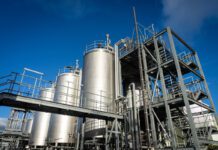
Johan Ostlund, director at CooperOstlund, gives five simple servicing tips to breathe new life into your AD plant and improve energy generation performance.
Working at full capability, 24 hours a day, inevitably takes its toll on the performance of any combined heat and power (CHP) engine. In our experience, poorly maintained engines can see efficiencies fall by as much as 20%. Indeed, a well-managed 500kW engine could be generating an additional £35,000 in revenues every year. Hence, CHP maintenance is not a ‘nice to do’ option – it could be the difference between profit and loss for your business!
Although you should closely follow the servicing intervals outlined by your manufacturer (typically 1,000, 10,000, 20,000, 40,000 and 60,000 running hours), there are a few simple self-service checks that can be taken in-between, which could dramatically improve your site’s overall performance and financial yield. So, as summer approaches – and the resulting challenges of dust, heat and humidity begin to take their toll – now is the perfect time to service your site and get your CHP engine back to its best.
1. Cleaning, unblocking and replacing filters
It sounds simple, but you’d be surprised how few AD sites check their CHP air filters for build-up and blockages. Dust and dirt will naturally enter the mesh, capable of blocking airflow. Obviously, with a reduced volume of air entering the engine, efficiency will noticeably drop and your energy generation will decrease accordingly.
This is the perfect starting point for self-servicing – simply unscrew the housing, remove the filter and clean as appropriate – a five-minute job. If you can see obvious damage, replace the entire filter, as this can allow debris to enter your engine, creating unnecessary damage. Spare parts are easily available and reasonably priced, so don’t let such a straightforward check impact on your generation potential.
Simple yet effective, cleaning filters can considerably improve the output of your CHP engine. This is something to check on a regular basis throughout the summer, as pollen and dust can clog filters up more quickly than in the winter months.
2. Checking and replacing pipework lagging
When generating power, CHP engines create significant exhaust heat (400-500ºC). This heat is a money-maker, receiving subsidy support via the Renewable Heat Incentive (RHI). The resulting heat is also capable of being used for a number of valuable tasks – including pasteurising AD digestate, keeping digestate warm to maximise the generation of biogas and providing heat for use elsewhere, such as farm buildings or adjacent businesses.
However, poor insulation and gaps in exhaust pipework lagging can see high proportions of this heat lost to the atmosphere, therefore reducing efficiencies and lowering financial return.
So, another simple check – which I would advise site managers to undertake at least every month – is a visual inspection of lagging. Is pipework effectively covered? Are there gaps in the lagging? Does the covering look worn and in need of replacing? Cheap and simple to replace, improving your exhaust lagging can have a huge impact on generation efficiency and, therefore, financial gains.
3. Checking fluid concentrations
During the winter months, having a high concentration of glycol in your coolant fluid is important to prevent engine freezing. However, it’s also important to remember that the chemical also reduces cooling potential. So, with summer on the way, now is the perfect time to drain your fluids and rebalance glycol levels to prevent overheating.
While doing this, also make a visual check of your coolant tank for any leaks or cracks. In our experience, leaking coolant can see 80kWh lost from a 500kWh engine. Any leaks, blockages or contamination can have much greater effects over the longer-term, so identifying problems early can make a huge difference to financial return.
Ensuring your fluids are of the highest quality is also a key servicing task. Earlier this month, we announced a UK partnership with Petro-Canada Europe Lubricants Ltd. The agreement sees our maintenance team use more than 350 specialist greases, speciality lubricants and environmental oils in a wide range of servicing applications. The prioritisation of fit-for-purpose products sees drain intervals double for our clients, with engine efficiency also improving.
We would advise using high quality products, such as the Petro-Canada range, to maximise the performance of your CHP engine. Although cheaper products can look more cost-effective on first glance, their regular replacement means costs will add up in the long-term.
4. Cleaning heat exchangers
Heat exchangers play a key role in any CHP engine, removing hot exhaust gas and transferring it to working fluid. However, even small deposits on the exchanger can lead to a rapid loss in efficiency, while frequent breakdowns and high flow temperatures are the more serious consequences.
To ensure the most effective heat transmission process possible, heat exchangers should be cleaned and serviced on a regular basis. Although the engine does have to be off-line in order to undertake this maintenance, ignoring the process will lead to loss of overall performance – impacting directly on financial return, so it is worth making this investment.
A simple clean will dramatically improve engine functioning and longevity, offering enormous savings for every site operator. So, although slightly more complicated than other ‘quick fix’ servicing tips, monitoring your heat exchangers should be a priority. You can either do this yourself, or look to an expert who will carry out the maintenance relatively cheaply.
5. Inspecting radiators
As the weather changes and temperatures rise, pollen and dust levels increase accordingly. Although unnoticeable to the naked eye, a constant build-up of fine particles can quickly block radiators – impeding the cooling process and reducing generation levels.
A quick visual inspection is all you need. Can you see daylight through the radiator? Is there any obvious build-up? If so, a simple clean can improve cooling efficiencies dramatically; maximising your engine’s performance and improving ROI.
Improving efficiency, lengthening engine lifespan, reducing wear and tear and minimising downtime – by undertaking a few simple self-service checks, any site operator can improve engine performance and reap financial rewards, be it self-sufficiency, reduced mains reliance or FiTs/RHI subsidies.
Although simple checks to boost the efficiency of your CHP engine are relatively straightforward, closely following servicing intervals and working with a professional maintenance service provider is essential for any AD facility.






